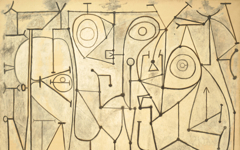Picasso’s Le Vert-Galant (1943)
As explained in the entry on Picasso’s still-life Mandolin and Guitar, the landscape here also forms a human head though less obviously so.
Click next thumbnail to continue

Picasso's Le Vert-Galant compared to a detail of Velazquez's Portrait of Queen Maria Theresa of Spain with two watches
Click image to enlarge.
If you are familiar with the work of Picasso’s favorite artists, you may recognize in the arch of foliage the elaborate floral headdress of Velazquez’s Spanish Queen, Maria Theresa. What, though, does Picasso mean? If, as is always the case, we are looking into the artist's imagination then the plants in the townscape are fused with the queen's headdress to suggest the fertility of Picasso's royal and androgynous mind.
Click next thumbnail to continue
More Works by Picasso
See how Picasso turns one scene into another in ways that have never been seen

Picasso’s Five Figures in a Boat (1909)
Notes:
Original Publication Date on EPPH: 07 Sep 2010. | Updated: 0. © Simon Abrahams. Articles on this site are the copyright of Simon Abrahams. To use copyrighted material in print or other media for purposes beyond 'fair use', you must obtain permission from the copyright owner. Websites may link to this page without permission (please do) but may not reproduce the material on their own site without crediting Simon Abrahams and EPPH.




